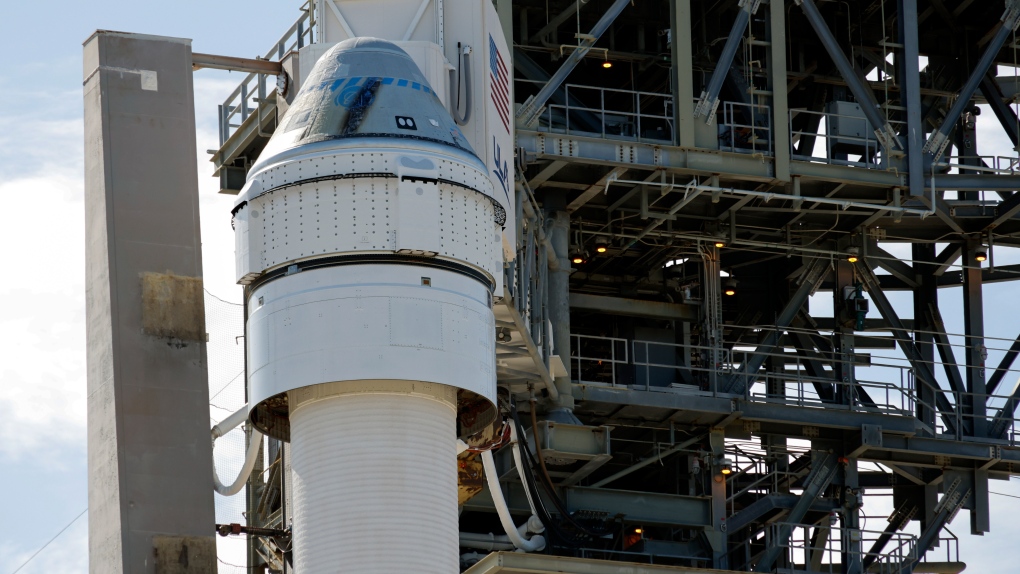CAPE CANAVERAL, Fla. –
Boeing’s new Starliner astronaut capsule was poised for launch on Monday night on a much-delayed first crewed test flight to orbit, as the company scrambles to compete with Elon Musk’s SpaceX for a greater share of lucrative NASA business.
The CST-100 Starliner with two astronauts aboard was due for liftoff at 10:34 p.m. (0234 GMT on Tuesday) from NASA’s Kennedy Space Center in Florida, carried atop an Atlas V rocket furnished by the Boeing-Lockheed Martin joint venture United Launch Alliance (ULA).
The gumdrop-shaped capsule and its crew are headed for a rendezvous with the International Space Station (ISS), two years after the Starliner completed its first test voyage to the orbital laboratory without astronauts aboard.
Boeing, whose commercial plane operations are in disarray after several sequential crises, badly needs a space win for its Starliner venture, a years-delayed program with more than $1 billion in cost overruns.
While Boeing has struggled, SpaceX has become a dependable taxi to orbit for NASA, which is backing a new generation of privately built spacecraft that can ferry its astronauts and other customers to the ISS and, under the space agency’s more ambitious Artemis program, to the moon and eventually Mars.
Starliner would compete head-to-head with SpaceX’s Crew Dragon capsule, which since 2020 has been NASA’s only vehicle for sending ISS crew to orbit from U.S. soil.
Riding aboard the Starliner, designed to carry up to seven crew members, are veteran NASA astronauts Barry “Butch” Wilmore, 61, a retired U.S. Navy captain, and Sunita “Sunni” Williams, 58, a former Navy aviator and test pilot.
They have logged a combined 500 days in space over the course of two missions each to the space station. Wilmore is the designated commander for Monday’s flight, with Williams in the pilot seat.
Although Starliner is designed to fly autonomously, the crew can assume control of the spacecraft if necessary. The test flight calls for Wilmore and Williams to practice maneuvering the vehicle manually.
Weather forecast favourable
Launch forecasts on Monday called for a 95 per cent chance of favorable weather conditions, and ULA said on social media that “all systems remain ‘go'” for an on-time liftoff.
The launch would mark the first crewed voyage to space using an Atlas rocket since the storied family of Atlas launch vehicles first sent astronauts, including John Glenn, on orbital flights for NASA’s Mercury program in the 1960s.
If all goes as planned, the capsule will arrive at the space station after a flight of about 26 hours and dock with the orbiting research outpost some 250 miles (400 km) above Earth early on Wednesday.
Wilmore and Williams are expected to remain at the space station for about a week before riding the Starliner back to Earth for a parachute and airbag-assisted landing in the U.S. Desert Southwest – a first for crewed NASA missions.
The test flight comes at an especially critical moment for Boeing. Its airplane business is dealing with fallout from a midair blowout of a cabin panel door plug on a nearly new 737 MAX 9 in January, as well as previous deadly crashes of two 737 MAX jets.
Getting Starliner to this point has been a fraught process for Boeing, beset by years of development setbacks and more than US$1.5 billion in charges for the aerospace giant on a US$4.2 billion fixed-priced contract with NASA.
The space agency wants the redundancy of having two different U.S. rides to the ISS, which is expected to retire around 2030. NASA is encouraging private development of new space stations that could replace the ISS after its retirement, potentially giving Starliner new destinations.
The first attempt by Boeing to send an uncrewed Starliner to the space station in 2019 failed due to dozens of software and engineering glitches. A second attempt in 2022 succeeded, paving the way for Monday night’s mission.
Depending on the outcome, Starliner is booked to fly at least six more crewed missions to the space station for NASA.
At a pre-flight briefing with NASA officials on Friday, Boeing vice president Mark Nappi said the company and the space agency were “in total agreement” that the Starliner was ready to fly with crew, adding, “we can’t be more confident.”
“Because it is a test flight, we give extra attention,” NASA chief Bill Nelson said. “That’s why we put two test pilots on board.”
(Reporting by Joey Roulette in Cape Canaveral, Florida, and Steve Gorman in Los Angeles; Writing by Steve Gorman; Editing by Sam Holmes and Will Dunham)


